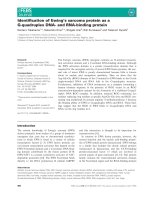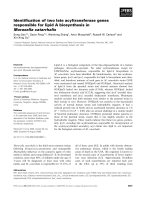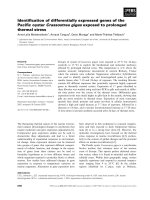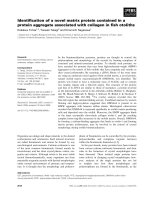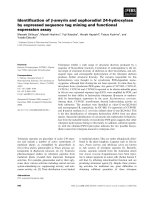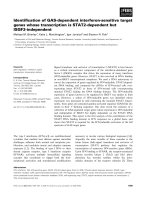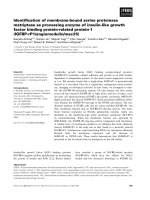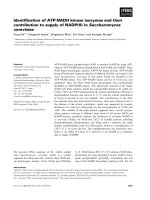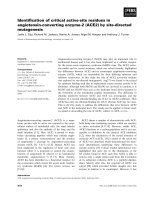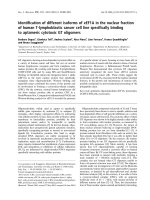Báo cáo khoa học: Identification of crucial residues for the antibacterial activity of the proline-rich peptide, pyrrhocoricin pot
Bạn đang xem bản rút gọn của tài liệu. Xem và tải ngay bản đầy đủ của tài liệu tại đây (522.34 KB, 12 trang )
Identification of crucial residues for the antibacterial activity
of the proline-rich peptide, pyrrhocoricin
Goran Kragol
1
, Ralf Hoffmann
2
, Michael A. Chattergoon
1
, Sandor Lovas
3
, Mare Cudic
1
, Philippe Bulet
4
,
Barry A. Condie
1
, K. Johan Rosengren
5
, Luis J. Montaner
1
and Laszlo Otvos Jr
1
1
The Wistar Institute, Philadelphia, PA, USA;
2
Biologisch-Medizinisches Forschungszentrum, Heinrich-Heine-Universita
¨
t,
Du
¨
sseldorf, Germany;
3
Department of Biomedical Sciences, School of Medicine, Creighton University, Omaha, NB, USA;
4
Institut de Biologie Moleculaire et Cellulaire, Strasbourg, France;
5
Institute for Molecular Bioscience, University of Queensland,
Brisbane, Australia
Members of the proline-rich antibacterial peptide family,
pyrrhocoricin, apidaecin and drosocin appear to kill
responsive bacterial species by binding to the multihelical lid
region of the bacterial DnaK protein. Pyrrhocoricin, the
most potent among these peptides, is nontoxic to healthy
mice, and can protect these animals from bacterial challenge.
A structure–antibacterial activity study of pyrrhocoricin
against Escherichia coli and Agrobacterium tumefaciens
identified the N-terminal half, residues 2–10, the region
responsible for inhibition of the ATPase activity, as the
fragment that contains the active segment. While fluo-
rescein-labeled versions of the native peptides entered E. coli
cells, deletion of the C-terminal half of pyrrhocoricin signi-
ficantly reduced the peptide’s ability to enter bacterial or
mammalian cells. These findings highlighted pyrrhocoricin’s
suitability for combating intracellular pathogens and raised
the possibility that the proline-rich antibacterial peptides can
deliver drug leads into mammalian cells. By observing strong
relationships between the binding to a synthetic fragment of
the target protein and antibacterial activities of pyrrhocori-
cin analogs modified at strategic positions, we further veri-
fied that DnaK was the bacterial target macromolecule.
In addition, the antimicrobial activity spectrum of native
pyrrhocoricin against 11 bacterial and fungal strains and the
binding of labeled pyrrhocoricin to synthetic DnaK D-E
helix fragments of the appropriate species could be correla-
ted. Mutational analysis on a synthetic E. coli DnaK frag-
ment identified a possible binding surface for pyrrhocoricin.
Keywords: antimicrobial peptides; cell penetration; heat
shock proteins; mutational analysis; pharmacophore.
In the desperate fight against antibacterial-resistant bacteria,
the proline-rich peptide family can come to the rescue [1].
The most active member of these peptides, pyrrhocoricin, is
nontoxic to healthy mice and eukaryotic cells, and at low
doses can protect mice from bacterial challenge [2]. Because
at high doses pyrrhocoricin is toxic to compromised
animals, pyrrhocoricin analogs were developed that lack
in vivo toxicity, even in infected mice, and show improved
stability in mammalian sera [2,3]. These designed peptides
efficiently kill various resistant strains and clinical isolates
[4]. The key feature to the ability of these peptides to kill
resistant bacteria is their novel mechanism of action.
Pyrrhocoricin, and other family members such as drosocin
and apidaecin appear to exhibit their antimicrobial activity
by binding to the bacterial heat shock protein DnaK [5],
preventing chaperone assisted protein folding and inhibiting
the strongly related ATPase activity of DnaK [6].
Similar to other antimicrobial peptides [7], and generally
peptides that penetrate mammalian cells [8], the proline-rich
peptides are also rich in cationic residues, arginine, lysine
and histidine. Cationic peptides interact electrostatically
with the negatively charged bacterial phospholipids and
then insert into the model membranes of planar bilayers or
liposomes [9,10]. Although these processes often involve the
formation of channels or pores, alternative mechanisms
were also suggested that either cooperatively destroy the
membrane barrier without channel formation [11] or just
create brief disruptions in permeability [12]. It is clear that
permeabilization of the cytoplasmic membrane to destroy
the membrane potential is not lethal per se [13]. This is
especially true for peptides that are rich not only in
positively charged residues but prolines as well [14]. For
example, it was argued that apidaecin or its mammalian
analog PR-39, enter bacterial cells without any disruption of
the membrane structure, and consecutively meet their
intracellular target biopolymer [15,16]. The special role of
proline residues has been best documented for buforin II,
an antimicrobial peptide acting on bacterial DNA and
RNA [17]. Confocal fluorescence microscopy studies show
that buforin II analogs with an intact proline hinge
penetrate Escherichia coli membranes without permeabili-
zation and accumulate in the cytoplasm [18]. When the key
proline is replaced with leucine, the preferred amino acid
residue in antibacterial peptides with amphipathic a-helical
structure [19], the ability of the peptide to accumulate
intracellularly is decreased, and therefore the antibacterial
activity is reduced.
The above results suggest that the DnaK-binding domain
of pyrrhocoricin may not span the entire molecule, and a
shorter active site can be identified that might not share the
Correspondence to L. Otvos, Jr., The Wistar Institute, 3601 Spruce
Street, Philadelphia, PA 19104, USA.
Fax: + 1 215 898 5821, Tel.: + 1 215 898 3772,
E-mail:
(Received 24 May 2002, revised 2 July 2002,
accepted 11 July 2002)
Eur. J. Biochem. 269, 4226–4237 (2002) Ó FEBS 2002 doi:10.1046/j.1432-1033.2002.03119.x
sequence with the fragment responsible for bacterial or
eukaryotic cell entry. Therefore, we studied the antibacterial
activity of a series of pyrrhocoricin analogs, in which either
each residue was replaced with alanine (Ala-scan) or
arginine-containing modules were inserted into strategically
important positions in the peptide. We also wanted to know
whether a pyrrhocoricin-based delivery mechanism could
promote entry into the less permeable mammalian cells [20].
When we ascertained that the Asp2–Pro10 fragment is the
most crucial domain for killing of E. coli and Agrobacte-
rium tumefaciens, we further investigated the interaction
between fluorescein-labeled pyrrhocoricin or its active or
inactive analogs and E. coli DnaK. In another line of
investigation, four pyrrhocoricin-responsive and seven
unresponsive bacterial and fungal strains were selected and
pyrrhocoricin’s binding to the corresponding DnaK D-E
helix was studied by fluorescence polarization. The anti-
bacterial activity correlated strongly with the binding to the
multihelical lid region of DnaK. Finally an Ala-scan on the
synthetic E. coli DnaK D-E helix fragment identified a
series of residues that could not be replaced without losing
binding to pyrrhocoricin. In the crystal structure of the
DnaK protein, these residues comprise a continuous
binding surface.
MATERIALS AND METHODS
Rationale for the design of the modified pyrrhocoricin
analogs
Modified pyrrhocoricin analogs were designed for studying
important residues and regions in the hypothetical active
site and delivery module (Table 1). First we concentrated on
the pharmacophore. In peptide Pyrr-mod1, a characteristic
turn-forming Pro8-Arg9 dipeptide motif in the active site
was replaced with helix-forming residues Glu and Ala. To
maintain the overall number of positive charges, the
apparently freely replaceable Ser5 was substituted with
Arg. The same design principles were applied to peptide
Pyrr-mod2 with an additional positive charge at the
Table 1. Synthetic peptides used in this study. Where appropriate, gaps are inserted to help the comparison of the different peptide sequences.
Unlabeled pyrrhocoricin analogs
Pyrrhocoricin
VDKG S YL P R PT P PR P IY NR N
Pyrr-mod1 VDKG R YL E A PT P PR P IY NR N
Pyrr-mod2 DKG RYL EAPTR PRP ERNRK
Pyrr-mod3 VDKG S YL P R PT P Y S PR P P IY NR N
Pyrr-mod4 VDKG S YL P R PT P T PR Y RP IY NR N
Fluorescein-labeled full-sized pyrrhocoricin derivatives
a
Fl-K-pyrrhocoricin 1-20 Fluorescein-K-VDKGSYLPRPTPPRPIYNRN
Fl-Pyrr-mod1 Fluorescein- VDKGRYLEAPTPPRPIYNRN
Fl-Pyrr-mod2 Fluorescein- VDKGRYLEAPTRPRPERNRK
Fl-Pyrr-mod3 Fluorescein- VDKGSYLPRPTPYSPRPPIYNRN
Fl-Pyrr-mod4 Fluorescein- VDKGSYLPRPTPTPRYRPIYNRN
Fl-K-Pyrr-mod4 Fluorescein-K-VDKGSYLPRPTPTPRYRPIYNRN
Pyrrhocoricin fragments (unlabeled and labeled)
b
K-Pyrr-1-10 K-VDKGSYLPRP
Fl-K-pyrrhocoricin 1-10 Fluorescein-K-VDKGSYLPRP
Fl-K-pyrrhocoricin 1-9 Fluorescein-K-VDKGSYLPR
Fl-K-pyrrhocoricin 11-20 Fluorescein-K-TPPRPIYNRN
Pyrr-10-20-K(Fl) PTPPRPIYNRN-K(Fluorescein)
DnaK and Hsp70 D-E helix fragments:
Escherichia coli 583-615
IEAKMQELAQVSQKLMEIAQQQHAQQQTAGADA
Agrobacterium tumefaciens 581-614 IQAKTQTLMEVSMKLGQAIYEAQQAEAGDASAEG
Haemophilus influenzae 583-615 IEAKIEAVIKASEPLMQAVQAKAQQAGGEQPQQ
Haemophilus ducreyi 583-615 IEAKIEAVIKASEPLMQAAQAKAQTNQAGEQQS
Helicobacter pylori 578-607 AELEDKTKLLAQAAQKLGEAMANKNNAEQP
Pseudomonas aeruginosa 584-615 IEAKMNALSQASTPLAQKMYAEQAQQGEDAPQ
Staphylococcus aureus 554-585 IKSKKEELEKVIQELSAKVYEQAAQQQQQAQG
Streptococcus pyogenes 554-588 MKAKLEALNEKAQALAVKMYEQAAAAQQAAQGAEG
Streptococcus pneumoniae 554-588 MKAKLEALNEKAQQLAVKLYEQAAAAQQAQEGAEG
Candida albicans 591-623 YEDKRKELESVANPIISGAYGAAGGAPGGAGGF
Mus musculus 595-626 (Hsp70-2) YEHKQKELERVCNPIISKLYQGGPGG
Homo sapiens 592-624 (Hsp70-1) FEHKRKELEQVCNPIISGLYQGAGGPGPGGFGA
a
The fluorescein-label was directly coupled to the amino-termini of the peptides.
b
The fluorescein-label was directly coupled to the amino-
termini of the peptides, except for the Pyrr-10-20-K(Fl) derivative in which the fluorescein was coupled to the side chain of the extra
C-terminal lysine residue. The Fl-K-pyrrhocoricin 1-9 and Fl-K-pyrrhocoricin 1-10 peptides behaved very similarly in every experiment,
and therefore data are provided only for the 1-9 analog that had been scrutinized for its ATPase inhibitory activity earlier [6]. The
fluorescence signal of the two C-terminal analogs was quenched very rapidly. They are part of our ongoing efforts to find a suitable
carboxy-terminal substrate.
Ó FEBS 2002 Multifunctional antimicrobial peptides (Eur. J. Biochem. 269) 4227
C-terminus to further promote cell entry. In addition, the
nonessential and freely replaceable Ile-Tyr dipeptide was
substituted with the Glu-Arg dipeptide to maintain good
solubility at any pH. Later we made changes only in the
C-terminal, nonessential region. In peptide Pyrr-mod3,
while the active site was kept intact, the characteristic Pro12-
Pro13 dipeptide fragment of the C-terminal domain was
disrupted, by inserting two hydroxy-amino acids that are
not foreign to pyrrhocoricin, but are normally located
outside the Pro-Arg-Pro repeats. To compensate for the
reduction of the percentage of Pro, an additional proline
was inserted after the last Pro, before the final IYNRN
segment. Finally, in peptide Pyrr-mod4 the same design
principles were used, except the inserted two hydroxy-amino
acids were separated, and the positive charge of the putative
cell-penetrating region was increased by inserting an addi-
tional Arg residue.
N-Terminally fluorescein-labeled peptides included full-
sized native pyrrhocoricin, apidaecin and drosocin [6], and
the N-terminal 1–9 fragment of pyrrhocoricin. In these
derivatives, 5(6)-carboxy-fluorescein was coupled to the
a-amino group of an extra N-terminal lysine residue. The
addition of this Lys was needed, because the antibacterial
activity of the pyrrhocoricins is lost upon directly blocking
the N-terminus without an extra positive charge ([2] and
Table 2). This positive charge apparently plays a role in the
interaction with bacterial membranes [21]. The Pyrr-mod1–
4 peptides were also synthesized with an N-terminal
fluorescein label, but because these peptides were designed
for fluorescence polarization studies, they did not contain
the extra lysine, except peptide Fl-Pyrr-mod4, which was
made both with and without the N-terminal Lys. In support
of the earlier findings, the peptide without the lysine lost its
antibacterial activity (Table 2). Table 2 also demonstrates
that the addition of the N-terminal lysine did not turn an
otherwise inactive peptide into an active one against E. coli
JC7623.
A series of peptides corresponding to the D-E helix regions
of different bacterial and eukaryotic DnaK/Hsp70 sequences
were synthesized. The different Hsp70 sequences were
dissimilar towards to C-termini of the proteins. The decision
as to which residues to select as C-termini depended upon
where a gap between the extended D-E helix and the short
extreme C-terminal domain was found. We observed the
earliest gaps for the H. pylori and the mouse sequences. To
have bacterial DnaK fragments of similar size, the H. pylori
peptide was extended by two residues toward the D-helix at
the N-terminus. The Salmonella typhimurium DnaK 584–
616 fragment has not been prepared because it is essentially
identical to the E. coli sequence except for a conservative
TAG fi AGS change very close to the C-terminus.
For the Ala-scan of the DnaK D-E helix region, all native
residues were replaced with alanine. The three native
alanines, Ala591, Ala601 and Ala606 were replaced with
phenylalanine. The sequence was not continued after
Thr610 because the C-terminal hydrophobic residues signi-
ficantly contribute to the low aqueous solubility of the full
583–610 fragment.
Peptide synthesis and purification
N-Terminally Fmoc-protected amino acids [22] were used
for the synthesis of the peptides. In the Ala-scans each
residue in pyrrhocoricin or each residue in the 583–610
E. coli DnaK fragment was replaced with alanine. The Ala-
scan peptides were assembled on a SYRO multiple peptide
synthesizer, and after cleavage were purified by RP-HPLC.
All other peptides were made individually, on a MilliGen
9050 continuous-flow automated synthesizer and were
purified by RP-HPLC until MALDI-MS revealed only
single species with the expected molecular ions. The mass
spectra were taken at the Wistar Institute Protein Micro-
chemistry Facility.
Fluorescence polarization
Binding of the synthetic DnaK fragments or the mutated
derivatives to fluorescein-labeled pyrrhocoricin or its ana-
logs was assessed by fluorescence polarization [23]. For
these experiments, the unlabeled peptides were serially
diluted in Tris buffer (pH 7.4) in 50 lL final volume in
6 · 50 mm disposable glass borosilicate tubes. The fluores-
ceinated pyrrhocoricin peptides were added to each tube in a
50-lL aliquot to a final concentration of 1 n
M
and tubes
were incubated at 37 °C for 5 min The extent of fluores-
cence anisotropy was measured on a Beacon 2000 fluores-
cence polarization instrument (PanVera, Madison, WI,
USA) and calculated as millipolarization values. The filters
used were 485 nm excitation and 535 nm emission with
3 nm band width. During fluorescence polarization, it is
assumed that one molecule of the labeled compound
interacts with one molecule of the unlabeled partner, and
while the concentration of the unlabeled larger molecule
determines the association constant, the concentration of
the labeled partner determines the fluorescence intensity.
The 1 n
M
tracer concentration, andother parameters used
herein, were successfully used in our laboratory earlier to
study peptide–peptide [6,24], peptide–protein [5] and pep-
tide–nucleic acid interactions [25].
In vitro
antibacterial assays
Antibacterial assays were performed in sterile 96-well plates
(Nunc F96 microtiter plates) with a final volume of 100 lL
Table 2. In vitro antibacterial activity of some pyrrhocoricin analogs
that are discussed in the text. In addition to the fluorescein-labeled Pyrr-
mod1 – Pyrr-mod4 pyrrhocoricin derivatives, the same peptide analogs
were labeled with biotin at their N-termini. Similar to the fluorescein-
derivatives, none of the biotin-labeled peptides exhibited activity up to
40 l
M
.
Peptide
IC
50
against
E. coli JC7623 (l
M
)
L
-pyrrhocoricin < 0.3
D
-pyrrhocoricin > 40
L
-pyrrhocoricin-1-10-
D
-pyrrhocoricin-11-20 > 40
Fl-K-pyrrhocoricin 1-20 20–40
Fl-Pyrr-mod1 > 40
Fl-Pyrr-mod2 > 40
Fl-Pyrr-mod3 > 40
Fl-Pyrr-mod4 > 40
Fl-K-Pyrr-mod4 10–20
K-pyrr-1-10 > 40
4228 G. Kragol et al. (Eur. J. Biochem. 269) Ó FEBS 2002
as described previously [26]. Briefly, 90 lL of a suspension
of a mid-logarithmic phase bacterial culture at an initial
600 nm UV absorbance of 0.001 in media required for good
growth of the various bacterial strains was added to 10 lL
of serially diluted peptides in sterilized water. The final
peptide concentrations ranged between 0.06 l
M
(lower) and
20–80 l
M
(upper). Plates were incubated at 37 °Cfor
16–24 h with gentle shaking, and growth inhibition was
measured by recording the increase of the UV absorbance at
600 nm on a microplate reader.
Cell penetration assay
To study the ability of the antibacterial peptides and their
fragments to enter cells, fluorescein-labeled peptides were
added to E. coli JC7623 cells or mouse macrophages at final
concentrations of 5 lgÆmL
)1
and 100 ngÆmL
)1
, respectively.
The cells were allowed to acquire the substrate for 60 min at
37 °C, the excess substrate was removed and the cells were
washed extensively with NaCl/P
i
, pH 6.8. The cells were
fixed with NaCl/P
i
buffer containing 1% paraformaldehyde
and visualized using a Leica TCS SPII laser scanning
confocal microscope (E. coli) or Leica DMIL fluorescence
microscope (macrophages).
Circular dichroism measurements
CD spectra were performed on a Jasco J720 instrument at
room temperature in a 0.2 mm pathlength cell. Doubly
distilled water was used as solvent. The peptide concentra-
tions were 0.5 mgÆmL
)1
, determined each time by quan-
titative RP-HPLC [27]. Curves were smoothed by the
algorithm provided by Jasco. Mean residue ellipticity
([h]
MR
) is expressed in degreesÆcm
2
Ædmol
)1
by using mean
residue masses of 110.
RESULTS
Identification of crucial residues for the antibacterial
activity of pyrrhocoricin
An Ala-scan was performed to identify key residues that
could not be replaced in pyrrhocoricin without a major loss
in antibacterial activity. For the bacterial strains, we selected
E. coli and A. tumefaciens because in our earlier studies we
had observed some differences in the potency of truncated
pyrrhocoricin peptides in killing these strains [28]. Accord-
ing to the Ala-scan, pyrrhocoricin had an identical bioactive
fragment against both strains (Fig. 1). No activity was
detected (up to 20 l
M
peptide) against either bacterium
whenAsp2,Lys3,Tyr6,Leu7,Pro8,Arg9orPro10were
replaced with alanine, indicating that the most crucial
residues for antibacterial activity were in the Asp2–Pro10
peptide fragment. Further investigations are required to
reveal whether the Asp2–Lys3 dipeptide is a functional part
of the pharmacophore. All other amino acids could be
replaced without a major loss in the antimicrobial activity of
the peptide, except Val1, Arg14 and Arg19, residues, which
are needed for the full antibacterial activity, at least against
A. tumefaciens. Some key N-terminal residues were also
replaced with tyrosine (Tyr-scan), resulting in identical
activity data.
Antibacterial activity of pyrrhocoricin analogs
The Ala- and Tyr-scans identified the N-terminus as the
fragment carrying essential residues for the antibacterial
activity and the C-terminus as a necessary domain, but
suitable for substitutions. To provide further support for
this notion, the antibacterial activity of the Pyrr-mod1–
Pyrr-mod4 analogs was studied in detail against clinical
strains of E. coli, A. tumefaciens, S. typhimurium, H. influ-
enzae, Klebsiella pneumoniae, P. aeruginosa and S. aureus.
Table 2 shows the half inhibitory concentration (IC
50
)
values against these bacteria. As we showed earlier, the
pyrrhocoricin analogs are inactive against S. aureus [5], and
no activity could be obtained with the new peptides, even if
the number of the positive charges was increased. When
modifications were made in the Tyr6–Pro10 active segment
(peptides Pyrr-mod1 and Pyrr-mod2) the activity was
completely lost against all five originally responsive strains.
Most, but not all, activity could be recovered by peptide
Pyrr-mod3, which had no modification in the Tyr6–Pro10
region. However in peptide Pyrr-mod4, a repeat of the
characteristic Thr11–Pro12 linker between the active seg-
ment and the C-terminal domain, coupled with the increase
of the positive charges needed for cell entry, resulted in a
peptide variant with increased antibacterial activity against
two of the five strains. When we synthesized pyrrhocoricin
from
L
-amino acid residues at the N-terminus (Val1-Pro10)
and
D
-amino acid residues at the C-terminus (Thr11-
Asn20), no activity against E. coli JC7623 was observed
(Table 2). Antibacterial peptides with mainly membrane-
disrupting mode of action are insensitive to the stereochem-
ical configuration of the constituent residues [29].
Peptide entry into
E. coli
cells
The experiments above indicated that the proline-rich
peptide family had multiple functions and functional
domains, and perhaps carried separate modules for cell
entry and other tasks leading to bacterial killing. Therefore,
we studied the ability of fluorescein-labeled pyrrhocoricin,
its fragments and modified analogs to enter E. coli JC7623
cells. Because these peptides are currently considered promi-
Fig. 1. In vitro antibacterial activity of alanine-substituted pyrrhocoricin
peptides (Ala-scan) against Escherichia coli D22 and Agrobacterium
tumefaciens. The data represent the IC
50
values, which were read as
half ultraviolet absorbance between full bacterial growth (no peptide
added) and medium. The assay was performed in poor broth medium.
Ó FEBS 2002 Multifunctional antimicrobial peptides (Eur. J. Biochem. 269) 4229
sing therapeutic drug candidates [1,3,4], and many emerging
resistant bacterial species are intracellular pathogens, we also
wanted to know whether the proline-rich antibacterial
peptide family was able to penetrate macrophages where
facultative or obligate bacteria often propagate.
N-Terminally labeled pyrrhocoricin, containing a lysine
residue between the label and the antibacterial peptide
(Fl-K-pyrrhocoricin 1–20), entered the bacterial cells very
efficiently (Fig. 2, top left image). The staining appeared to
be homogenous throughout the entire cell body. Although
the isolated 1–9 fragment of pyrrhocoricin is inactive in the
in vitro antibacterial efficacy test [2], this fragment binds to
the D-E helix region of bacterial DnaK and inhibits the
ATPase activity of the heat shock protein [6]. We wanted to
see whether the lack of antibacterial activity could be
correlated with less efficient cell entry. Indeed, much weaker
labeling of the E. coli cells was observed for the N-terminal
1–9 fragment (Fl-K-pyrrhocoricin 1–9), carrying the
fluorescein chromophore and the extra lysine residue in a
position identical to that of full-sized pyrrhocoricin (Fig. 2,
top right image). Not only fewer cells were labeled with the
shortened pyrrhocoricin fragment, but perhaps more
importantly, the fluorescence intensity seemed to concen-
trate to the cell surface as the staining pattern of single cells
indicated (Fig. 2, middle images). Widespread distribution
of the drug inside bacterial cells is needed for efficient
inhibition of the putative intracellular target protein. When
a similarly labeled construct of Pyrr-mod4 was studied
(Fl-K-Pyrr-mod4), the bacterial cell penetration profile was
not significantly different from that of full-sized pyrrhoco-
ricin, indicating that the function of the C-terminal module
was not compromised with the amino acid changes and
insertions in this domain. The removal of the Lys residue
that connected the fluorescein moiety and Val1 of the
antibacterial peptide analog resulted in a major decrease in
the number of E. coli cells labeled by Fl-Pyrr-mod4,
consistent with the significant reduction in the antibacterial
activity (Table 2). Nevertheless, when Fl-Pyrr-mod4 with-
out the extra lysine did enter bacterial cells, the peptide
analog was homogenously distributed all over the cell
interior (Fig. 2, bottom right image). Fl-Pyrr-mod1 without
the extra lysine entered similar number of cells and
underwent intracellular distribution in an identical fashion
(Fig. 2., bottom left image), indicating that there were no
major differences in the cell penetration and distribution
pattern of naked Pyrr-mod1 or Pyrr-mod4. Rather, the
considerably stronger antibacterial activity of naked Pyrr-
mod4 (Table 3) was due to its actions on the intracellular
target molecule. In addition to bacterial cells, fluorescein-
labeled analogs of the three native peptides with the Lys
Fig. 2. Confocal fluorescence microscopic
images of E. coli JC7623 cells upon incubation
with fluorescein-labeled pyrrhocoricin analogs.
The peptide substrates are as follows: Fl-K-
pyrrhocoricin 1–20, top and middle left; the
analogous N-terminal half, Fl-K-pyrrho-
coricin 1–9, top and middle right; the Fl-Pyrr-
mod1 peptide without a Lys between the
fluorescein label and the peptide analog,
bottom left; and a similarly built Fl-Pyrr-
mod4 construct, bottom right.
4230 G. Kragol et al. (Eur. J. Biochem. 269) Ó FEBS 2002
inserted at the N-terminus between the label and the
peptides were added to murine macrophage cultures.
Pyrrhocoricin, apidaecin and drosocin penetrated into
mammalian cells without having preference to any partic-
ular cell compartment, including the cell membrane (not
shown). Similar to the results observed on bacterial cells, the
identically labeled pyrrhocoricin 1–9 fragment penetrated
into the mouse macrophages much less effectively. This also
confirmed that while the N-terminus served as the pharma-
cophore and hence the interactive domain with the bacterial
target protein, the C-terminal half aided the delivery of the
pharmacophore into the interior of cells.
These studies require a detailed analysis of the permis-
sibility of fluorescein substitutions at various positions in the
peptide. Addition of fluorescein significantly reduces the
antibacterial activity of pyrrhocoricin, much more than any
other substitution does ([2] and Table 2), even if the Lys
residue is incorporated between the label and the peptide.
Therefore, the current cell penetration studies were restric-
ted to peptides that could be labeled with fluorescein at the
original N-termini in an identical manner. The fluorescence
intensity of C-terminally labeled pyrrhocoricin fragments
quenched very rapidly (compare with Table 1). In addition,
the extra lysine residue alone did not generate antibacterial
activity above that present without this addition. The
K-Pyrr-1–10 peptide fragment was just as inactive against
E. coli JC7623 as any other pyrrhocoricin fragments
truncated to half size.
Connection between antibacterial activity
and pyrrhocoricin binding to the D-E helix region
of DnaK
Previously, we documented that pyrrhocoricin binds to a
synthetic version of the D-E helix region of E. coli,a
responsive species, but fails to bind to the homologous
fragment of the unresponsive species S. aureus [6]. Here, we
extended these studies to four responsive and seven
unresponsive bacterial and fungal species. Table 3 shows
that native pyrrhocoricin killed E. coli, A. tumefaciens,
S. typhimurium,andH. influenzae, among others, and
failed to kill S. aureus. Very weak activity, often read as
inactive [3], was found against P. aeruginosa. Some other
pyrrhocoricin-unresponsive bacterial and fungal strains
include S. pyogenes, C. albicans [4], S.pneumoniae, H. duc-
reyi and H. pylori. In addition, the peptide is not toxic to
healthy mice or eukaryotic cells [2]. Fragments of the
DnaK/Hsp70 sequences of the above-listed bacterial and
fungal strains and of mouse and human were synthesized
and their binding to N-terminally fluorescein-labeled pyr-
rhocoricin (with the extra lysine inserted) was studied by
fluorescence polarization. The synthetic DnaK peptides
encompassed the D and E helices and a short fragment of
the unordered region C-terminal to the multihelical lid
assembly (Table 1). Because the corresponding sequences of
E. coli and S. typhimurium DnaK are almost identical, and
from other studies we know that the TAGADA C-terminal
hexapeptide fragment of the E. coli sequence (where these
minor mutations are found) is not needed for the binding,
the S. typhimurium peptide was not synthesized. The K
d
between E. coli D-E DnaK and fluorescein-labeled pyrrho-
coricin is in the order of 50 l
M
[6], is expected to be lower
for the full-sized protein, and correlates well with the
5–10 l
M
antibacterial activity of the same fluorescein-
labeled pyrrhocoricin against E. coli [2]. One set of the
binding studies was carried out at a receptor fragment
concentration of 15 l
M
, below the peptide–peptide associ-
ation constant, serving the data as baseline values. The
highest concentration of the synthetic DnaK fragment was
250 l
M
, where all responsive sequences were expected to
bind. In summary, strong pyrrhocoricin binding to the D-E
DnaK helix region of the three (four) responsive strains was
observed, and no or very low binding was found to the
DnaK fragments of the seven nonresponsive, or very weakly
responsive strains (Fig. 3). Significantly, no binding was
detected to the mouse or human Hsp70 fragment, confirm-
ing the lack of specific binding to the human equivalent of
DnaK [5].
While modifications in the active segment of pyrrhoco-
ricin resulted in the complete disappearance of the antibac-
terial activity, changes made in the C-terminal delivery unit
retained at least some activity (Table 3). To further correlate
the ability to kill certain bacteria and DnaK binding, we
studied the interaction between the E. coli D-E helix DnaK
fragment and fluorescein labeled Pyrr-mod1–4 peptides. In
essence, the fluorescence anisotropy was not increased
compared to the baseline when the inactive Pyrr-mod1 or
Pyrr-mod2 peptides were added to the synthetic DnaK
fragment. However, when the active Pyrr-mod3 and Pyrr-
mod4 peptides were added, significant increases in the
fluorescence anisotropy were detected, once again showing
full correlation between DnaK binding and antimicrobial
activity (Fig. 4). These experiments further confirmed the
location of the pharmacophore (i.e. DnaK binding site)
between Asp2 and Pro10 in pyrrhocoricin. It needs to be
mentioned that in these labeled Pyrr-mod1–4 peptides, no
cationic amino acid, needed for the antibacterial activity of
N-terminally labeled pyrrhocoricin analogs [2], was inserted
Table 3. In vitro antibacterial activity of modified pyrrhocoricin peptides. One quarter strength of Muller-Hinton broth was used as the medium for
the growth of E. coli, A. tumefaciens, K. pneumoniae and P. aeruginosa; 1/4 strength of brain-heart infusion for S. typhimurium and H. influenzae (for
the latter one the medium was supplemented with NAD) and poor broth medium was used for S. aureus.
Peptide
IC
50
(l
M
) against
E. coli A. tumefaciens S. typhimurium K. pneumoniae H. influenzae P. aeruginosa S. aureus
Pyrrhocoricin < 0.1 < 0.3 2.5–5 1.25–2.5 2.5–5 10–20 > 20
Pyrr-mod1 > 20 > 40 > 20 > 20 > 20 > 20 > 20
Pyrr-mod2 > 20 > 40 > 20 > 20 > 20 > 20 > 20
Pyrr-mod3 < 0.1 0.6–1.25 5–10 5–10 5–10 > 20 > 20
Pyrr-mod4 0.1–-0.3 0.6–1.25 1.25–2.5 1.25–2.5 1.25–2.5 > 20 > 20
Ó FEBS 2002 Multifunctional antimicrobial peptides (Eur. J. Biochem. 269) 4231
between the label and Val1. A combination of these data
and those represented by Fig. 2 demonstrated that while an
increased number of positive charges at the amino terminus
was required for the gross antibacterial activity, the DnaK
binding and cell distribution studies could proceed with
analogs lacking the lysine insert.
Conformation of the DnaK fragments
Although we assumed that the lack of pyrrhocoricin
binding to some of the DnaK D-E helix sequences directly
reflected the lack of pyrrhocoricin activity against these
bacteria, it was possible that alterations in the physical or
biochemical properties of the synthetic protein fragments
played roles in our inability to detect positive interaction
between the peptides. One of the potential sources of
altered behavior can be a change in the trademark helical
conformation of the DnaK fragments. To exclude this
scenario, we compared the secondary structure of the D-E
helix peptides by CD spectroscopy. CD spectra were
taken in water, and water/trifluoroethanol mixtures [30].
All DnaK fragments exhibited very similar spectra
regardless of whether they bound to pyrrhocoricin or
not. Here we present the data on E. coli and S. aureus
(Fig. 5). In water, the CD spectra of both DnaK
fragments could be assigned as a type C spectrum [31],
and reflected the dominance of type I (III) b-turns, or a
mixture of type I and type II turns [32]. Addition of 5%
trifluoroethanol (v/v) resulted in a redshift of both pp*
bands to 190 and 204 nm, respectively, accompanied by
an increase of the intensity of the positive band which is a
clear indication of the appearance of helical structures.
The two DnaK fragments behaved identically, at least in
spectral terms. While the spectral features of well-devel-
oped a-helices could already be seen at a trifluoroethanol
concentration as low as 10%, the intensity was increased
with increasing trifluoroethanol content. The spectra of
the E. coli and S. aureus peptides remained very similar in
all water/trifluoroethanol compositions studied. If any
difference could be detected it was a minor intensity
increase throughout and some redshift (around 1 nm) at
low trifluoroethanol concentrations for the S. aureus
sequence compared to the E. coli peptide. This could be
explained by the increased number of potential salt
bridges along the helix barrel. The S. aureus peptide
contained 3 and 5 potential Glu–Lys salt bridges in i,i+3
and i,i+4 positions, respectively. These figures for the
E. coli fragment were 2 and 0. The isolated peptide
fragments thus exhibited all helical features of the
complete DnaK multihelical lid; the fragments were very
similar but not identical. Having said this, pyrrhocoricin
binding was not directly related to the helical content as
determined by fluorescence polarization (data not shown).
The millipolarization values between E. coli DnaK 583–
615 and Fl-K-pyrrhocoricin decreased as the trifluoroeth-
anol content of the solvent increased in the 0–10%
trifluoroethanol range. No fluorescence anisotropy could
be detected when the solvent contained more the 10%
trifluoroethanol.
The CD studies further verified the binding of pyrrho-
coricin to the E. coli DnaK fragment and the lack of a
sequence analogous to that of S. aureus (Fig. 6). To study
the interaction of the antibacterial peptide and the synthetic
DnaK D-E helix fragments, we looked at the conformation
of the E. coli DnaK 583–615 or the analogous S. aureus
DnaK 554–585 peptide–pyrrhocoricin mixtures as shown
by CD. If the sum of the individual CD curves of the two
interacting partners is different from the CD of the ligand–
receptor mixture, it is a clear indication of not only binding,
but also of a conformational change upon interaction.
Indeed, such a spectral alteration was detected for the
binding fragment of the responsive strain E. coli, but not
for the nonbinding fragment of the unresponsive strain
S. aureus (Fig. 6). If any consequence for the nature of the
Fig. 4. Interaction of 1 n
M
fluorescein-labeled pyrrhocoricin analogs
with the E. coli DnaK 583–615 fragment. The concentration of the
unlabeled protein fragment was 125 l
M
. The fluorescence anisotropy
data are expressed as the difference in the millipolarization values
between samples containing both the labeled antibacterial peptides and
the E. coli receptor fragment, or the appropriate labeled pyrrhocoricin
analogs alone.
Fig. 3. Binding of fluorescein-labeled pyrrhocoricin to various synthetic
DnaK D-E helix fragments as studied by fluorescence polarization. In
these experiments, the N-terminally fluorescein-labeled pyrrhocoricin
derivative at 1 n
M
concentration was added to synthetic D-E helix
DnaK fragments that were applied at either 250 l
M
or 15 l
M
. The
data are expressed as the difference in the millipolarization values
between samples containing both the labeled antibacterial peptide and
the given receptor fragments, or labeled pyrrhocoricin alone. The fig-
ure shows the average of 10 readings taken after a 5 min incubation
period. These experiments were repeated two times with basically
identical outcomes.
4232 G. Kragol et al. (Eur. J. Biochem. 269) Ó FEBS 2002
conformational change was to be drawn, the decrease of the
intensity of the 200 nm band representing the unordered
structure suggests the generation of a more ordered
conformation.
Identification of the pyrrhocoricin binding surface
on
E. coli
DnaK
Encouraged by the success of the Ala-scan in identifying the
essential residues of pyrrhororicin for antibacterial activity,
we used a similar strategy to identify essential residues in
E. coli DnaK for pyrrhocoricin binding. For this purpose
each residue in the 583–610 D-E helix fragment was
replaced with alanine. Phenylalanine was substituted for
the three native alanines in the sequence. Binding to
N-terminally fluorescein-labeled and Lys extended pyrrho-
coricin was studied by fluorescence polarization. The
fluorescence anisotropy showed a ladder-type interaction
pattern that probably reflected the presence of vital residues
for the binding and flanking residues likely needed to
maintain the structural integrity at the interaction sites
(Fig. 7). The major drop in the fluorescence polarization
signal was observed when Glu7 (Glu589 in the full protein),
Gln13 (Gln595) or Met16 (Met598) were replaced with Ala.
Additional important residues were Gln6 (Gln588), Gln10
(Gln592), Leu15 (Leu597), Ala19 (Ala601), Gln20 (Gln602)
and Gln22 (Gln604). Figure 7 shows an average of three
independent measurements and is cut at 12 millipolarization
units, which represents pyrrhocoricin binding to the native
Fig. 6. Circular dichroism spectra of DnaK
D-E helix–pyrrhocoricin mixtures in water.
First, the individual peptide spectra were col-
lected, followed by the spectra of the anti-
bacterial peptide–protein fragment mixtures.
While the measured spectrum of the E. coli
fragment–pyrrhocoricin mixture is different
from the mathematical sum of the individual
spectra, and indicates a conformational
change upon interaction, no similar alteration
could be detected for the unresponsive strain
S. aureus.
Fig. 5. Circular dichroism spectra of E. coli
and S. aureus DnaK D-E helix fragments in
trifluoroethanol-water mixtures. The spectra
were taken at room temperature and the
peptide concentration was approximately
0.5 mgÆmL
)1
. Both peptides underwent a
characteristic turn–helix transition as the tri-
fluoroethanol concentration increased.
Fig. 7. Binding of fluorescein-labeled pyrrhocoricin to alanine-substi-
tuted E. coli DnaK D-E helix analogs as studied by fluorescence polar-
ization. In these experiments, the N-terminally fluorescein-labeled
pyrrhocoricin derivative at 1 n
M
concentration was added to the Ala-
scan of synthetic D-E helix DnaK fragments that were applied at
150 l
M
. The data are expressed as the difference in the millipolariza-
tion values between samples containing both the labeled antibacterial
peptide and the D-E helix analogs, or labeled pyrrhocoricin alone. The
figure shows the average of three independent experiments conducted
from freshly purified samples; in each, 10 readings were taken after a
5 min incubation period.
Ó FEBS 2002 Multifunctional antimicrobial peptides (Eur. J. Biochem. 269) 4233
E. coli DnaK 583–610 sequence. In reality, substitution of
some residues increased rather than decreased the fluores-
cence anisotropy. The reason for this finding is still unclear;
it may indicate stronger binding to the mutated peptides, an
increased fluorescence signal due to a somewhat shifted
binding site or simply solubility differences.
DISCUSSION
Proline-rich delivery modules
To reach the cell interior, antibacterial peptides have to cross
the bacterial membrane. To fight pathogens living inside
host cells, peptides generally have to enter eukaryotic cells as
well. In the current study, we looked at the entry of
pyrrhocoricin, drosocin and apidaecin into E. coli cells and
macrophages, host cells of intracellular bacteria such as
Mycobacterium tuberculosis or Mycobacterium leprae. The
full-sized peptides entered the cells and became distributed in
all cellular compartments, suggesting an efficient transport
mechanism for these molecules. In our previous report, we
suggested that in addition to the target protein, DnaK, the
60 kDa chaperonin protein family, GroEL in bacteria and
Hsp60 in mammalian cells, can serve such a purpose [5].
Remarkably, when full-sized peptides were studied, no
selective surface staining of the cells could be detected by
confocal fluorescence microscopy. Such surface staining
is characteristic for alternating arginine-leucine contain-
ing biooligomers and other membrane-destabilizing
antimicrobial peptides, including magainin 2 [18]. In con-
trast, the PRP or similar repeat sequences in the proline-rich
antibacterial peptide family assist the entry into the host and
subsequently into bacterial cells without any potential to
destabilize the cells, and therefore become toxic to eukar-
yotes. The antibacterial activity of the native products is
provided by the independently functioning active site,
capable of binding to the D-E helix region of bacterial
DnaK and preventing chaperone-assisted protein folding [6].
Proline-rich cell penetration modules may be general for
antibacterial peptides in nature. Bovine myeloid cathelicidins
carry precursors of broad spectrum antimicrobial peptides
characterized by N-terminal amphipathic a-helices and
C-terminal hydrophobic tails [33]. Antibacterial peptides
with amphipathic helices or sheets are considered to act on
the negatively charged bacterial membranes by creating a
strong dipole moment and destroying the energy gradient
across the membrane [34]. Indeed, the C-terminal tails of the
cathelicidins are not needed for the antibacterial activity with
the truncated peptides containing only the amphipathic
helices being equally active against a selection of both Gram-
negative and Gram-positive bacteria [33]. However, a 5- to
10-fold higher concentration of the truncated analogs is
required to achieve a kinetics of permeabilization similar to
that of the respective parent peptides, suggesting a somewhat
less effective initial interaction with the target bacterial
membranes [33]. An examination of the cathelicidin hydro-
phobic tail sequences (PVIPLLHR and PIIVPIIRI) reveal
strong similarities to C-terminal tails of pyrrhocoricin
(PPRPIYNRN), drosocin (SHPRPIRV) or apidaecin
(PHPRI). Apparently, regardless of the mechanism for
peptide-mediated killing of bacteria, the highly similar cell-
penetrating modules may serve as first interaction points
with the membrane surface and help the internalization of
the peptides. In turn, this may suggest that some individual
antibacterial peptides or peptide families for which we
originally assumed a membrane-only mode of action [1] may
have intracellular targets too, just the sequences responsible
for nonmembrane activity are disguised by the ubiquitous
presence of membrane-targeting delivery modules.
Interaction between pyrrhocoricin and bacterial
biopolymers from the viewpoint of the antibacterial
peptide
The essential region of pyrrhocoricin for the antibacterial
activity was located between Asp2 and Pro10. The identi-
fication of the Asp2–Pro10 active segment is in full
agreement with our earlier model of pyrrhocoricin–DnaK
interactions. In our previous report [6], we showed a model
of how pyrrhocoricin remains close to the E-helix of E. coli
DnaK after applying a flexible docking algorithm. When we
look at this model from the angle of the E helix barrel, it is
evident that the pyrrhocoricin fragment that most intimately
touches DnaK is exactly the experimentally identified Tyr6–
Pro10 hexapeptide segment [35]. The pyrrhocoricin 1–9
fragment alone (or pyrrhocoricin 1–10 for that matter)
penetrated into cells very inefficiently but was an absolute
requirement for antibacterial activity. Pyrrhocoricin is
shown to bind to DnaK both inside and outside the
peptide-binding pocket [6]. The N-terminal region might
play roles in the association with molecular chaperones
(DnaK or GroEL) that serve as transport vehicles for the
peptide. Consistent with this, an application of the predi-
cative algorithm for nonspecific interaction of peptides with
the conventional peptide binding pocket of E. coli DnaK
[36] reveals a high probability of the N-terminal trideca-
peptide fragment of pyrrhocoricin associating with the heat
shock protein (energy score )5.0), but not when the
13-residue window starts from Gly4 (energy score +4.7).
Significantly, the side-chain of Thr11, located at the border
of the pharmacophore and the delivery unit, appeared not
to drastically influence the antimicrobial activity. This
observation is compatible with our earlier findings showing
that the native sugar addition to Thr11 has no influence on
the gross antibacterial activity [28]. The presence of the
carbohydrate side-chain, however, may modify either the
binding to the target protein or the ability of the peptide to
penetrate cells via through-space effects. The importance of
Arg19 was documented previously, when we reported that
the deletion of the C-terminal Arg19–Asn20 dipeptide
results in a reduction of the activity against A. tumefaciens
[28]. The partial loss of activity after replacing the two
C-terminal arginines suggests that this region is responsible
for the initial interaction of pyrrhocoricin with the negat-
ively charged bacterial surface and the ensuing entry into
bacterial cells.
The modified C-terminal delivery module featuring an
increased number of the Arg–Pro segments had an advant-
age against two strains that have more resistant membrane
structures, S. typhimurium and H. influenzae. Even if the
C-terminal fragment was not directly involved in binding to
the target protein, it still interacted with a biopolymer in a
stereospecific manner. The weak activity of native pyrrho-
coricin against P. aeruginosa, a gram negative strain known
to have an outer membrane that is difficult to penetrate [37],
may reflect either only a low ability of the peptide to
4234 G. Kragol et al. (Eur. J. Biochem. 269) Ó FEBS 2002
disintegrate this membrane structure or very weak binding
to the target protein. A Lys1-containing analog of pyrrho-
coricin shows improved activity against both E. coli and
P. aeruginosa, potentially shifting the dominant mode of
action from DnaK inhibition to membrane disintegration
[21]. N-Terminally blocked cecropin analogs, known to kill
bacteria by disassembling the membrane structure, lack
antibacterial activity [29]. All these suggest that the
N-terminal charges play an equally important role in the
interaction with bacterial membranes, but this might be
decoupled from the distribution of the peptides in the cells.
The N-terminally labeled Pyrr-mod4 analog without the
extra lysine bound to DnaK, was well dispersed inside
E. coli cells, but labeled a smaller number of bacterial or
mammalian cells, and therefore was unable to kill E. coli
(Table 2). It is tempting to speculate that antimicrobial
peptides with intracellular targets form a loop and interact
with the negatively charged bacterial membranes with both
termini and not with only one side, as was impressively
demonstrated previously [15]. Alternatively, the two
charged domains could interact with spatially and tempor-
ally separated bacterial components.
Concerning the specific interaction between the antimi-
crobial peptides and bacterial DnaK, the antibacterial
activity and selective binding to the D-E helix region of the
70 kDa heat shock protein was strongly correlated. Pyr-
rhocoricin bound to the representative synthetic fragments
of the highly responsive strains E. coli, S. typhimurium,
A. tumefaciens and H. influenzae,butfailedtobindtothe
homologous fragments from the nonresponsive strains
S. aureus, S. pyogenes, H. pylori, H. ducreyi, S. pneumoniae,
C. albicans or the weakly responsive strain P. aeruginosa.
Further support for the connection between binding to the
D-E helix of DnaK and antibacterial activity came from the
Pyrr-mod1–4 analogs. The antibacterial activity of pyrrho-
coricin analogs that were modified in either the active site or
in the C-terminal unit and binding to the protein fragment
was strongly correlated. In addition, the native peptide
lacked binding to the homologous region of mouse or
human Hsp70 confirming the lack of specific peptide
binding to full-sized human Hsp70 [5] or toxicity to
mammalian cells and healthy mice [2].
Interaction between pyrrhocoricin and DnaK
from the viewpoint of the heat shock protein
To identify a potential pyrrhocoricin-binding surface on
E. coli DnaK, here we analyzed the important residues for
the interaction based on the published X-ray structure of the
protein. In Fig. 8, we displayed the surface of the C-terminal
domain (residues 533–606) in semitransparent gray [38],
then marked the synthetic 583–606 fragment in ball and
stick inside the surface. Due to the lack of ordered structure
C-terminal to Ala606, the rest of the synthetic DnaK
peptide is excluded from this graphical representation. The
crucial residues for pyrrhocoricin binding based on Fig. 7
are colored in Fig. 8 blue (most important) and green
(important). This exercise identifies an L-shaped binding
surface, including the primary binder linear surface com-
prising residues Gln13 (Gln595 in the full protein), Met16
(Met598), Ala19 (Ala601) and Gln20 (Gln602), and the
secondary surface attached in an 80 degrees angle featuring
Gln6 (Gln588) and Gln10 (Gln592). Additional essential
residues, Lys14 (Lys596), Leu15 (Leu597) and Ile18 (Ile600)
are involved in the stabilization of the correct fold of DnaK
for pyrrhocoricin binding. Of these, Leu597 and Ile600 have
no or very little surface exposure (calculated by [39]), but
make hydrophobic contacts with neighboring essential
residues. While Leu597 strongly influences the proper
side-chain orientation of the highly important residue
Met598, Ile600 touches the aliphatic portion of the side
chain of Lys596. The apparently very significant residues
Glu7 (Glu589) and Gln22 (Gln604) have surface exposure,
but are facing the opposite direction. These hydrophilic
residues probably maintain the aqueous solubility required
for the successful fluorescence polarization assay of the
otherwise not very soluble synthetic DnaK D-E helix
peptide fragment.
This model would well explain the lack of activity against
all the negative bacterial strains and higher organisms.
H. pylori, P. aeruginosa, S. aureus, S. pyogenes, S. pneumo-
niae, C. albicans, M. musculus and H. sapiens all lack both
Met16 and Gln20 (compare with Table 1). These residues
are present in the responsive strain H. influenzae and the
homologous unresponsive strain H. ducreyi. The two
Fig. 8. Possible pyrrhocoricin-interacting resi-
dues in E. coli DnaK. The published structure
of the C-terminal domain of E. coli DnaK [38]
is displayed in semitransparent. The synthetic
583–606 fragment, used for the Ala-scan is
marked with ball and stick representation
inside the surface. The crucial residues for
pyrrhocoricin binding based on the Ala-scan
are labeled blue (most important) and green
(important). The likely primary and secondary
binding surfaces are highlighted by blue and
green patches, respectively.
Ó FEBS 2002 Multifunctional antimicrobial peptides (Eur. J. Biochem. 269) 4235
protein fragments are identical until a Val fi Ala change at
residue 601, and another fully homologous stretch of
residues until Gln606 followed by nine nonidentical residues
(Table 1). By coincidence, in E. coli residue 601 was found
important for binding, but because of the altered residues in
H. infleunzae and H. ducreyi in positions 596 and 600, a
valine in H. influenzae might allow stronger binding than an
alanine in H. ducreyi. Alternatively, the residues responsible
for the positive pyrrhocoricin binding in H. influenzae
DnaK and negative binding in H. ducreyi DnaK are located
outside the 533–606 fragment used for modeling or 583–610
fragment used for the mutational analysis. It is possible that
the pyrrhocoricin binding site may be shifted in other bac-
teria compared to E. coli. If we look at the sequence of
A. tumefaciens this is indeed a viable possibility. In A. tum-
efaciens a methionine and a glutamine are found in positions
13 and 17, exactly three residues N-terminal to the crucial
Met16 (Met598) and Gln20 (Gln602) of E. coli DnaK.
Multiple peptide-binding sites on heat shock proteins were
most recently shown to exist, both in thermodynamic and
kinetic experiments [40,41]. The precise assignment of
the contact residues between pyrrhocoricin and E. coli,
H. influenzae and A. tumefaciens DnaK is currently in
progress in our laboratories by using additional computa-
tional techniques, DnaK D-E helix analog arrays and NMR
measurements.
ACKNOWLEDGEMENTS
The authors wish to thank Drs Hildegund C.J. Ertl and John D. Wade
for critical reading of the manuscript. The Wistar Institute Microscopy
Facility is thanked for expert help with the confocal microscopic
studies.
REFERENCES
1. Otvos, L. Jr (2000) Antibacterial peptides isolated from insects.
J. Pept. Sci. 6, 497–511.
2. Otvos, L. Jr, Bokonyi, K., Varga, I., Otvos, B.I., Hoffmann, R.,
Ertl,H.C.J.,Wade,J.D.,McManus,A.M.,Craik,D.J.&Bulet,P.
(2000) Insect peptides with improved protease-resistance protect
mice against bacterial infection. Protein Sci. 9, 742–749.
3. Cudic, M., Bulet, P., Wade, J.D., Kragol, G., Condie, B.A. &
Otvos, L. Jr (2001) Fully solid-phase synthesis and anti-microbial
properties of a cyclic analog of pyrrhocoricin. In Peptides 2000
(Martinez, J. & Fehrentz, J.A., eds), pp. 203–204. Editions EDK,
Paris.
4. Cudic, M., Condie, B.A., Weiner, D.J., Lysenko, E.S., Xiang,
Z.Q.,O,I.,Bulet,P.&Otvos,L.Jr(2002)Developmentofnovel
antibacterial peptides that kill resistant clinical isolates. Peptides in
press.
5. Otvos,L.Jr,O,I.,Rogers,M.E.,Consolvo,P.J.,Condie,B.A.,
Lovas, S., Bulet, P. & Blaszczyk-Thurin, M. (2000) Interaction
between heat shock proteins and antimicrobial peptides. Bio-
chemistry 39, 14150–14159.
6. Kragol, G., Lovas, S., Varadi, G., Condie, B.A., Hoffmann, R. &
Otvos, L. Jr (2001) The antibacterial peptide pyrrhocoricin inhibits
the ATPase actions of DnaK and prevents chaperone-assisted
protein folding. Biochemistry 40, 3016–3026.
7. Wu, M., Maier, E., Benz, R. & Hancock, R.E.W. (1999)
Mechanism of interaction of different classes of cationic anti-
microbial peptides with planar bilayers and with the cytoplasmic
membrane of Escherichia coli. Biochemistry 38, 7235–7242.
8. Futaki, S., Suzuki, T., Ohashi, W., Yagami, T., Tanaka, S., Ueda,
K. & Sugiura, Y. (2001) Arginine-rich peptides: an abundant
source of membrane-permeable peptides having potential as car-
riers for intracellular protein delivery. J. Biol. Chem. 276, 5836–
5840.
9. Christensen, B., Fink, J., Merrifield, R.B. & Mauzerall, D. (1988)
Channel-forming properties of cecropins and related model com-
pounds incorporated into planar lipid membranes. Proc. Natl
Acad. Sci. USA 85, 5072–5076.
10. Lehrer, R.I., Barton, A., Daher, K.A., Harwig, S.S.L., Ganz, T. &
Selsted, M.E. (1989) Interaction of human defensins with
Escherichia coli. Mechanism of bactericidal activity. J. Clin. Invest.
84, 553–561.
11. Shai, Y. (1995) Molecular recognition between membrane-span-
ning polypeptides. Trends Biochem. Sci. 20, 460–464.
12. Matsuzaki,K.,Mitani,Y.,Akada,K.Y.,Murase,O.,Yoneyama,
S., Zasloff, M. & Miyajima, K. (1998) Magainins as paradigm for
the mode of action of pore forming polypeptides. Biochemistry 37,
15144–15153.
13. Friedrich, C.L., Moyles, D., Beveridge, T.J. & Hancock, R.E.
(2000) Antibacterial action of structurally diverse cationic peptides
on gram-positive bacteria. Antimicrob. Agents Chemother. 44,
2086–2092.
14. Cudic, M. & Otvos, L. Jr (2002) Intracellular targets of anti-
bacterial peptides. Curr. Drug Targets 3, 101–106.
15. Gallo, R.L. & Huttner, K.M. (1998) Antimicrobial peptides: an
emerging concept in cutaneous biology. J. Invest. Dermatol. 111,
739–743.
16. Castle, M., Nazarian, A., Yi, S S. & Tempst, P. (1999) Lethal
effects of apidaecin on Escherichia coli involve sequential mole-
cular interactions with diverse targets. J. Biol. Chem. 274, 32555–
32564.
17. Park, C.B., Kim, H.S. & Kim, S.C. (1998) Mechanism of action of
the antimicrobial peptide buforin II: buforin II kills microorgan-
isms by penetrating the cell membrane and inhibiting cellular
functions. Biochem. Biophys. Res. Commun. 244, 253–257.
18. Park, C.B., Yi, K., Matsuzaki, K., Kim, M.S. & Kim, S.C. (2000)
Structure-activity analysis of buforin II, a histone H2A-derived
antimicrobial peptide: the proline hinge is responsible for the cell-
penetrating ability of buforin II. Proc. Natl Acad. Sci. USA 97,
8245–8250.
19. Oren, Z., Hong, J. & Shai, Y. (1997) A repertoire of novel anti-
bacterial diastereomeric peptides with selective cytolytic activity.
J. Biol. Chem. 272, 14643–14649.
20. Hancock, R.E.W. & Diamond, J. (2000) The role of cationic
antimicrobial peptides in innate host defenses. Trends Microbiol. 8,
402–410.
21.Bencivengo,A M.,Cudic,M.,Hoffmann,R.&Otvos,L.Jr
(2001) The efficacy of the antibacterial peptide, pyrrhocoricin, is
finely regulated by its amino acid residues and active domains.
Lett. Pept. Sci. 8, 201–209.
22. Fields, G.B. & Noble, R.L. (1990) Solid-phase peptide synthesis
using 9-fluorenylmethoxycarbonyl amino acids. Int. J. Pept. Pro-
tein Res. 35, 161–214.
23. Lundblad, J.R., Laurence, M. & Goodman, R.H. (1996) Fluor-
escence polarization analysis of protein-DNA and protein–protein
interactions. Mol. Endocrinol. 10, 607–612.
24. Otvos, L. Jr, Pease, A M., Wade, J.D. & Hoffmann, R. (1998)
Glycosylation of the fourth repeat unit of human s-protein abol-
ishes binding to the C-terminal acidic s-binding segment of
b-tubulin. Prot. Pept. Lett. 5, 207–213.
25. Hoffmann, R., Craik, D.J., Pierens, G., Bolger, R.E. & Otvos, L.
Jr (1998) Phosphorylation of the C-terminal sites of human p53
reduces non-sequence specific DNA binding as modeled with
synthetic peptides. Biochemistry 37, 13755–13764.
26. Bulet,P.,Urge,L.,Ohresser,S.,Hetru,C.&Otvos,L.Jr(1996)
Enlarged scale chemical synthesis and range of activity of droso-
cin, an O-glycosylated antibacterial peptide from Drosophila. Eur.
J. Biochem. 238, 64–69.
4236 G. Kragol et al. (Eur. J. Biochem. 269) Ó FEBS 2002
27. Szendrei,G.I.,Fabian,H.,Mantsch,H.H.,Lovas,S.,Nyeki,O.,
Schon, I. & Otvos, L. Jr (1994) Aspartate-bond isomerization
affects the major conformations of synthetic peptides. Eur. J.
Biochem. 226, 917–924.
28. Hoffmann,R.,Bulet,P.,Urge,L.&Otvos,L.Jr(1999)Rangeof
activity and metabolic stability of synthetic antibacterial glyco-
peptides from insects. Biochim. Biophys. Acta 1426, 459–467.
29. Vunnam, S., Juvvadi, P. & Merrifield, R.B. (1997) Synthesis and
antibacterial action of cecropin and proline-arginine-rich peptides
from the pig intestine. J. Pept. Res. 49, 59–66.
30. Nelson, J.W. & Kallenbach, N.R. (1986) Stabilization of the
ribonuclease S-peptide a-helix by trifluoroethanol. Proteins 1, 211–
217.
31. Gierasch,L.M.,Deber,C.M.,Madison,V.,Niu,C H.&Blout,
E.R. (1981) Conformations of (X-L-Pro-Y)
2
cyclic hexapeptides.
Preferred beta turn conformers and implications for beta-turns in
proteins. Biochemistry 20, 4730–4738.
32. Perczel, A., Hollosi, M., Sandor, P. & Fasman, G.D. (1993) The
evaluation of type I and type II b-turn mixtures. Circular
dichroism, NMR and molecular dynamics studies. Int. J. Peptide
Protein Res. 41, 223–236.
33. Skerlavaj,B.,Gennaro,R.,Bagella,L.,Merluzzi,L.,Risso,A.&
Zanetti, M. (1996) Biological characterization of two novel
cathelicidin-derived peptides and identification of structural
requirements for their antimicrobial and cell lytic activities. J. Biol.
Chem. 271, 28375–28381.
34. Gudmundsson, G.H. & Agerbeth, B. (1999) Neutrophil anti-
bacterial peptides, multifunctional effector molecules in the
mammalian immune system. J. Immunol. Methods 232, 45–54.
35. Otvos, L. (2002) The short, proline-rich antibacterial peptide
family. Cell. Mol. Life Sci. 59, 1138–1150.
36. Rudiger, S., Germeroth, L., Schneider-Mergener, J. & Bukau, B.
(1997) Substrate specificity of the DnaK chaperone determined by
screening cellulose-bound peptide libraries. EMBO J. 16, 1501–
1507.
37. Kitahara, T., Yoneyama, H. & Nakae, T. (1997) Antibiotic dif-
fusion pathways in the outer membrane of Pseudomonas aerugi-
nosa. Biochem. Biophys. Res. Commun. 238, 457–461.
38. Zhu, X., Zhao, X., Burkholder, W.F., Gragerov, A., Ogata, C.M.,
Gottesman, M.E. & Hendrickson, W.A. (1996) Structural analysis
of substrate binding by the molecular chaperone DnaK. Science
272, 1606–1014.
39. Koradi, R., Billeter, M. & Wuthrich, K. (1996) MOLMOL: a
program for display and analysis of macromolecular structures.
J. Mol. Graph. 14, 29–32.
40.Thulasiraman,V.,Yun,B G.,Uma,S.,Gu,Y.,Scroggins,
B.T. & Matts, R.L. (2002) Differential inhibition of Hsc70
activities by two Hsc70-binding peptides. Biochemistry 41, 3742–
3753.
41. Koller, M.F., Baici, A., Huber, M. & Christen, P. (2002) Detection
of a very rapid phase in complex formation of DnaK and peptide
substrate. FEBS Lett. 520, 25–29.
Ó FEBS 2002 Multifunctional antimicrobial peptides (Eur. J. Biochem. 269) 4237
